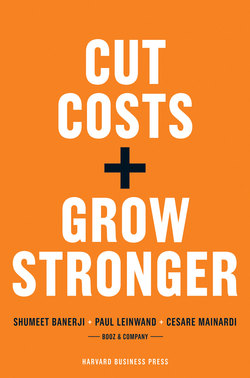Читать книгу Cut Costs, Grow Stronger : A Strategic Approach to What to Cut and What to Keep - Paul Leinwand - Страница 9
На сайте Литреса книга снята с продажи.
Changing the Conversation About Costs
ОглавлениеIF YOU ARE LIKE MOST executives, you have been spending a lot of time lately thinking about costs. Many businesses are struggling to survive, as the worst global economic crisis in more than seventy years unfolds. Others, even if they’re doing relatively well right now, are reducing expenses to make sure they are well prepared for future uncertainty. The pressure to cut costs—whether driven by your cash flow, your shareholders, your uncertainty, or your investment needs—is extraordinary.
But there is a positive side to this situation. Dramatic cost cutting gives you a chance to refine or even reformulate your overall strategy. After all, you’re never just cutting costs. You’re making a decision that something is no longer strategically relevant, and that other things are essential to keep. Yes, you may have to lose some product lines and activities, and perhaps some of your employees and customers. You also, however, have the opportunity to help your company grow stronger in the process.
We reject—and you should emphatically reject—the idea that cutting costs makes your business weaker or more limited. Sustained cost reduction tends to correlate with corporate performance over time; the perceived opposition between these two goals is a false dichotomy. To be sure, if you reduce expenses in a panic, or without an eye to strategy, you could do great harm to your company’s competitiveness. But if you focus on your priorities and on your future potential, cutting costs can be a catalyst for exactly the change you need.
The current moment of financial stress—indeed, any moment of cost pressure—is a signal from the world at large to your business. It is saying that you need to choose your strengths and use them more effectively. The signal may also be telling you that the market has changed, and that old paths to profit are uncertain. It is time to put your stake in the ground, to say what your company is about and what it needs to become, and to make many of the hard choices that your company has needed to make for some time.
Why tackle the challenge of cost cutting so explicitly? Because most companies are cutting costs ineffectively. They focus, mechanically and program-matically, on the topic of cost. They either spread the pain as evenly as they can across the company or target high-cost areas first. And they look for short-term reductions without fully considering the impact on their long-term position or prospects. Figure 1-1, summarizing surveys conducted with executives of leading corporations, shows how strongly these approaches prevail. When companies cut costs this way, they risk making the enterprise weaker and (in many cases) they doom themselves to more cost cuts down the road.
FIGURE 1-1
Cost reduction and revenue growth priorities
Faced with mounting pressure to cut-costs, most companies continue to go about it the wrong way. Executives are assigning higher priority to short-term cost-reduction tactics and demonstrating less appetite for longer term initiatives. They have defaulted to standard downturn defenses such as across-the-board cost-cutting and layoffs
Instead, we say that cost itself is an outcome of the choices you make about where to invest. The right way to think about costs—whether or not your company is under huge pressure now—is to take a hard look at the capabilities you need most and to invest only in those that will give you a “right to win” in the marketplace. The resulting approach is unique for each company and results in greater and faster cost reduction, less risk to the business, less chance of costs returning, and a greater likelihood that you’ll have made the company stronger and positioned it to grow more quickly when good times return.
This approach involves a new way of thinking about capabilities. We have found that previous research in the field—about skill sets, core competencies, and individual corporate functions—does not go far enough. The capabilities of a company need to be seen for what they are: a defining factor in its productivity, a critical element of its success, and a major factor in determining its strategy. (We say more about this in chapter 2.) Some of the themes we’ll discuss and illustrate with examples are that your company’s key capabilities:
Drive most or all of your worthwhile discretionary costs
Can be counted on one hand (as opposed to reflecting the multitude of priorities within your business)
Should be among the expenses spared in a cost-cutting program (they may even be increased)
Work best when they are combined in sets to deliver a unique, hard-to-copy capability system
Are rarely if ever bounded by individual corporate functions
Can determine the composition of a high-performing portfolio of businesses—those that pull from similar capability systems
Lend themselves to scale advantages, but need not always be built or maintained in-house
Represent, in combination, the difference between what matters and what doesn’t
